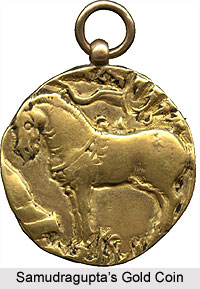 Samudragupta was the famous ruler of the Gupta dynasty, under whom Gupta Empire was destined to attain dazzling success and prosperity. Samudragupta, the son of Chandragupta I by his Licchavi queen, Kumaradevi, succeeded his father to the throne. With the ascension of Samudragupta to the throne of the Gupta Dynasty, the Guptas attained conspicuous superiority over all the important authorities and was transformed from the local powers in Gangetic valley into a pan Indian Imperial authority.
Samudragupta was the famous ruler of the Gupta dynasty, under whom Gupta Empire was destined to attain dazzling success and prosperity. Samudragupta, the son of Chandragupta I by his Licchavi queen, Kumaradevi, succeeded his father to the throne. With the ascension of Samudragupta to the throne of the Gupta Dynasty, the Guptas attained conspicuous superiority over all the important authorities and was transformed from the local powers in Gangetic valley into a pan Indian Imperial authority.
The Allahabad Prasasti composed by Harishena, delineates a vivid description of the reign of Samudragupta. In the fourth stanza, there is a vivid description of the nomination of Samudragupta as his successor, by Chandragupta I. It is described that Chandragupta declared his son Samudragupta as his successor in a full session of the royal court. The Allahabad Pillar inscription also delineates the civil war, which was the immediate result of Chandragupta`s declaration.
From the Allahabad Pillar inscription it is known that Samudragupta had to confront various obstacles after he was declared the successor of Chandragupta I. There was a difference between the ministers and royal kinsmen on account of his succession - the immediate result of which was the civil war. As is suggested in the Allahabad Prasasti, Chandragupta I abdicated the throne in favour of his son and successor Samudragupta. As a result, the other princes of equal birth, who aspired for the throne, were disappointed and they revolted against Samudragupta under the leadership of Kacha. Kacha was supposed to be the elder son of Chandragupta. It is however presumed by the scholars that the Licchavi marriage of Chandragupta had divided the Gupta court into two opposite factions. The orthodox section was against the Licchavi faction and degraded them on account of their inferior culture, in comparison to the orthodox Brahmanical culture. The Licchavis at that time was considered the `Bratyas` or the `fallen Kshatriyas`. Henceforth the nomination of Samudragupta alienated the orthodox faction in the court, who apprehended the supremacy of Bratya culture of the Licchavis in royal court. Hence they supported Kacha, the eldest son of Chandragupta I against Samudragupta, the successor of Chandragupta I.
Kacha was the advocate of superior Brahmanical culture of the Gupta dynasty. Hence he was hostile towards Samudragupta, a Licchavi descendant. But however there is a keen controversy among historians regarding the hostility of Kacha towards Samudragupta. According to S.B. Gayal, the antagonism between Kacha and Samudragupta was for idealistic causes and not individual. Kacha was impatient towards any culture apart from traditional Brahmanical culture of superior quality. This theory of Dr. Gayal can be supported from the evidences of the contemporary period. Kacha`s hostility for Buddhism can be proved from his condemnation in a Buddhist
treatise-`Arya-Manjusri-Mula-Kalpa`. Some coins bearing the name of Kacha and a Brahmi legend "Sarvarajochetta" have been found in the regions, famous as the centres of orthodox Brahmanical Culture. Therefore the resentment of Kacha for Samudragupta represented the struggle between two opposite cultures, with which the factional rivalry in court became entangled. Dr smith also corroborated the theory of Dr.Gayal and identified Kacha with the rival brothers of Samudragupta. Dr.Bhandarkar however discarded the view of Dr Gayal and Dr.Smith and identified "Kacha" with Rama Gupta. But the theory of Dr. Bhandarkar is generally discarded due to the fact that he was a cowardly man and that he could not claim the title "Sarvarajochetta". The view that Kacha was the elder brother of Samudragupta is widely accepted. It has also been suggested by modern scholars that the fragmentary stanzas of 5 and 6 in Allahabad Prasasti referred to the revolt. However Samudragupta crushed the revolt successfully. But the civil war, or the rivalry for the throne was by no means certain. Later Allan, on the basis of numismatics evidences has contended the theory of civil war and puts forward that Samudragupta and Kacha were the same person. But this theory was discarded on the basis of the different pattern of coins issued in the name of Samudragupta and that of Kacha. Nevertheless the general belief runs that Samudragupta ascended the throne after suppressing the civil war, the outcome of fraternal bitterness.



















